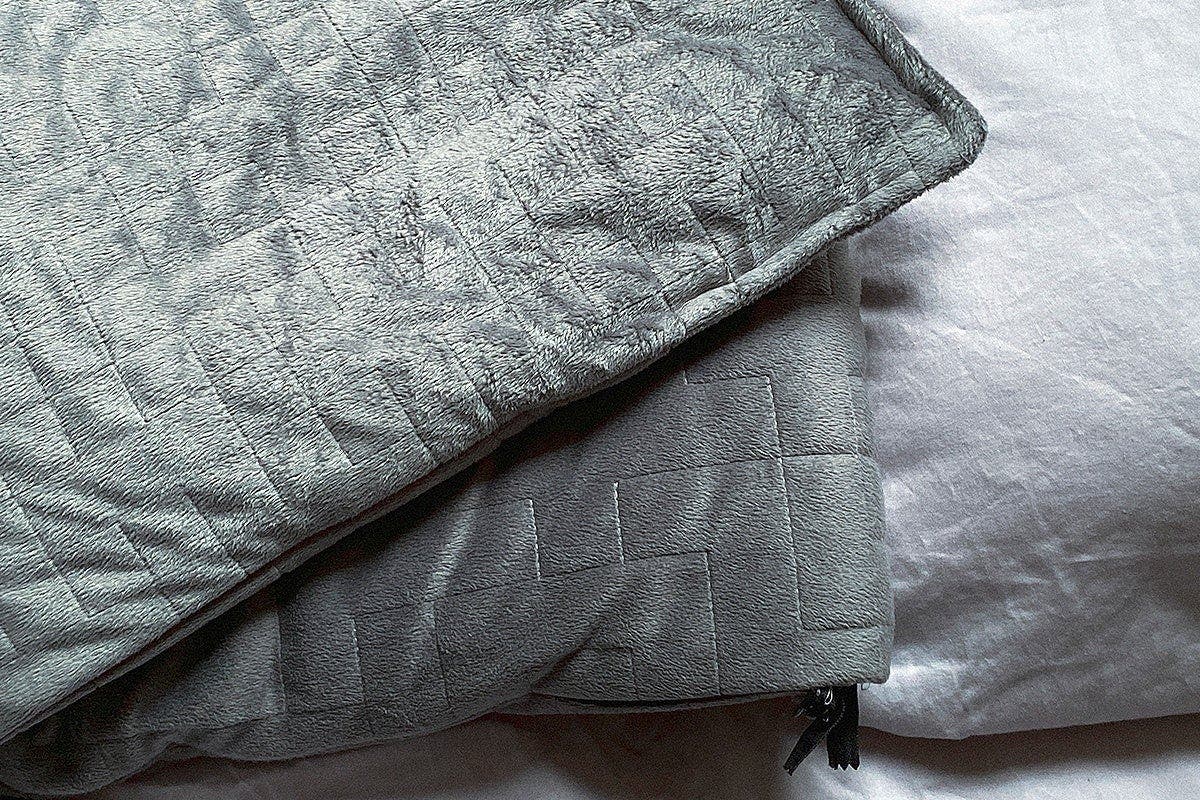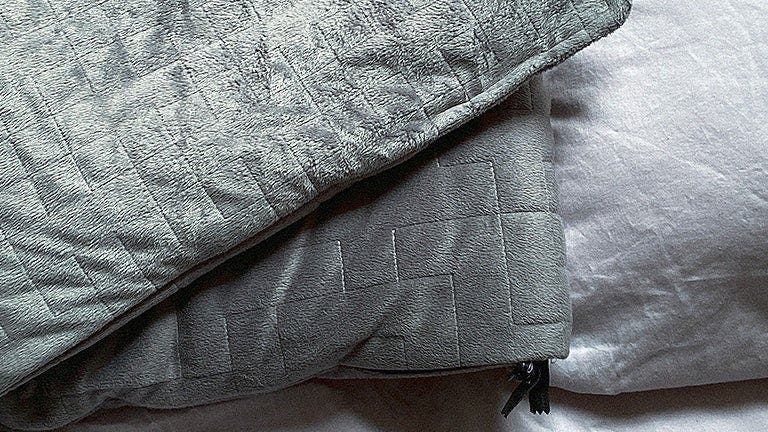Weighted Blankets: What Are the Benefits, and Do They Work?


Newborns are tightly swaddled. Toddlers sleep with security blankets. Now adults have their own bedtime anxiety-reducers: weighted blankets.
Weighted blankets have soared in popularity over the past few years as product reviews and evolving research have begun to link them to improvements in stress, insomnia, and many other ailments. But do weighted blankets really work? Here’s the deal:
What is a weighted blanket?
Typically, a weighted blanket—or “gravity blanket”—replaces your comforter or duvet: Made with six-by-six-inch square segments stuffed with glass or plastic pellets that are stitched into a large quilt, they can weigh anywhere from four to 25 pounds or more, ideally distributing about 10 percent of your body weight evenly. (Because the ideal weight is different for different people, it’s best to hog your weighted cover even if you share a bed.)
“The goal is to give you the feeling that the blanket is almost hugging your body,” says Bill Fish, certified sleep science coach and founder of Tuck.com. “This gives you a sense of calmness that can reduce stress and help you stay asleep so your body can go through the necessary stages and wake up feeling fully rested.”
Weighted blanket benefits: combatting anxiety and sleep issues
“The science behind weighted blankets points to a ‘cocooning’ benefit which may elevate feelings for comfort and relaxation, possibly through an increase in oxytocin, a powerful bonding hormone,” says Alex Dimitriu, M.D., a physician who is board certified in psychiatry and sleep medicine and the founder of Menlo Park Psychiatry and Sleep Medicine. “Additionally, adults may have maintained an association between being swaddled in infanthood and relaxing, which may even go back to our days in the womb.”
Studies also suggest that the benefits of weighted blankets stem from deep pressure stimulation, a form of touch that appears to reduce anxiety by releasing serotonin. (For reference, you might experience this phenomenon after a massage.)
Serotonin, in turn, helps the body produce melatonin, the chemical that tells us we’re sleepy when the sun goes down. “A weighted blanket may aid in reducing insomnia,” Dr. Dimitriu concludes, speaking to the physiological benefits that can improve sleep quality without medication. Additionally, people who use weighted blankets tend to report a more comfortable, better quality, and more secure sleep, he adds.
That said, only a few small studies have looked at the benefits of weighted blankets specifically: In 2015, Swedish researchers who gave 31 adults 30-pound weighted blankets found that those with chronic insomnia slept better and experienced fewer psychological symptoms after two weeks: Sixty-three percent of participants reported lower anxiety and 78 percent said the weighted blanket calmed them down. What’s more, research involving patients with autism and other intellectual conditions have surfaced similar benefits.
The American Sleep Association says that weighted blankets are “a great, medication-free treatment for getting to sleep,” but, they add, if you have sleep problems, it’s always a good idea to check with your doctor before solutioning on your own.
RELATED: Your Guilt-Free Guide to a Mental Health Day
How to choose the best weighted blanket
The best weighted blanket for, according to guidelines accepted by most clinicians and used in research, should weigh 10 percent of your body weight, give or take a few pounds, says Rafael E. Salazar II, a board-certified occupational therapist based in Georgia who uses weighted blankets in his work. That means the average man or woman, who weighs 195.7 or 168.5 pounds respectively, according to the National Center for Health Statistics, should look for an approximately 20- or 15-pound weighted blanket.
You’ll find two main types of fill in weighted blankets: plastic poly pellets and micro glass beads. The pellets are usually made of plastic and will create a bumpier blanket. Micro glass beads have less of a profile and lay flat against you. “Look to ensure that the weighted beads in the blanket are evenly distributed to ensure that one portion of the blanket is not heavier than another,” Fish says. “If you’re unable to roll over beneath your weighted blanket and have any feeling of being trapped, look for something a bit lighter.”
While weighted blankets can be quite costly—they range from $100 to $250 or more—higher quality materials and construction can deliver a better experience, according to Fish. It takes strong materials to secure the weighted sections of a blanket; cheap blankets that use polyester and subpar stitching are more likely to fall apart, which keeps the weight from being distributed evenly and the blanket from doing its job.
Another pro tip: Find one with a washable cover so you can clean it. Most blankets come in a range of colors and patterns and are made from breathable fabrics, which should prevent you from getting hot while you sleep. (You may still need to use thinner blankets or sheets under the weighted blanket to get used to the heavy sensation.)
Are weighted blankets safe for kids?
Weighted blankets work by providing deep proprioceptive sensory input to those who use them, Salazar says. “This type of sensory input has been shown to provide a ‘calming’ effect for individuals with a sensory processing disorder, those experiencing anxiety or stress, and even children with ADHD,” he says.
Does that mean you should be using a weight blanket for kids? The biggest safety concern when it comes to kids is the risk of suffocation. “If the weighted blanket weighs too much, the child is too young or weak to move under it, or if the blanket gets over the child's face, there is a risk of suffocation,” Salazar says.
To that point: At least two deaths have been linked to weighted blankets: a 9-year-old autistic boy who was rolled up in a heavy blanket, and a 7-month-old baby.
“We normally don’t recommend a weighted product for a child until they can stand on their own, and, even then, we would suggest going less than 10 percent than the body weight of the child,” adds Fish.
If you’re considering using a weighted blanket for your child, Salazar recommends introducing brief, five- to 15-minute weighted blanket sessions—that is, after running it by your child’s doctor. Even for adults, weighted blankets are not meant for a full night’s sleep, but rather 30- to 40-minutes of usage followed by a 60- to 90-minute break to prevent muscle fatigue and desensitization. “If there seem to be positive affects in a child, then you could explore increasing the length of time and begin using it as needed) throughout the day,” Salazar says.
How to make a weighted blanket
It is possible to DIY a weighted blanket, but it’s not a super easy process, says Jeanine Joy, Ph.D., lead editor of SleepTips.org.
You can buy the beads on Amazon and there are lots of tutorials on YouTube. But “the best way to do it is to use an inner blanket with at least one side in a plaid so it’s easy to sew straight lines,” Joy says. (You'll need a sewing machine unless you want to spend a lot of time sewing stitches by hand.) Once you create a line of pockets for the beads, you’ll need to separate the beads into groups of equal weight and funnel them into the pockets. “A faster way to make the inner pocket is to use an over-the-door shoe organizer and sew the top of each compartment closed with the beads enclosed,” Joy says. “Then tack them to the inside of a duvet cover outer blanket.” No matter what, you should use a duvet as an outer blanket so you can remove and wash it.
FYI: “If you don't already have basic sewing skills, you'll spend a lot of time and energy making a blanket and you won't save that much money after you buy the materials,” Joy says.
Do weighted blankets work?
There probably isn’t enough scientific data yet to say whether weighted blankets work or not, but the anecdotal evidence is there—and the placebo effect can be very real.
“While there are studies showing that weighted blankets can help reduce anxiety and stress, there are also studies showing that they don't help with sleep or insomnia,” Salazar says. “Even in the studies that showed that weighted blankets may not have had any ‘statistically significant’ or ‘clinically significant’ effects, a large number of the individuals who used them preferred them over regular blankets and reported that they did find the blanket to have a calming effect.”
Whether the positive benefit is real or perceived, a weighted blanket might help—and it’s unlikely to make things worse. “I sometimes recommend weighted blankets to patients with the general belief that unless they are too restricting or too hot, they will generally do little harm,” Dr. Dimitriu says. “If they help, everyone wins, and the side effects are indeed minimal.”
Kimberly Holland is a journalist and author based in Birmingham, Alabama with more than a decade of experience in creating wellness, food, and healthy living content. Her first book, Collagen Handbook: Recipes for Natural Living will be published in January 2020.
Ashley Mateo has over a decade's worth of experience covering fitness, health, and lifestyle topics for national magazines and websites. She is also a UESCA-certified running coach.
